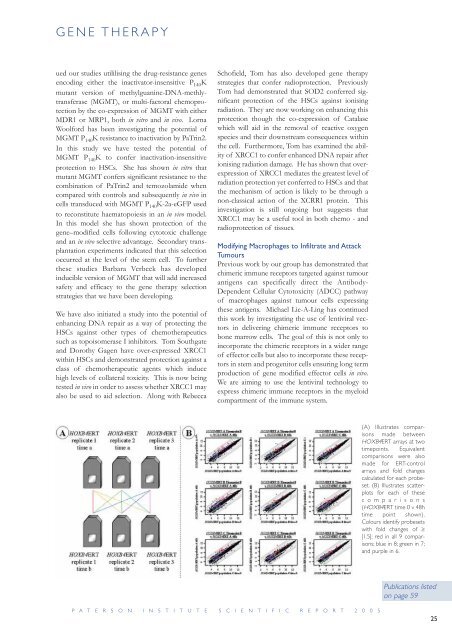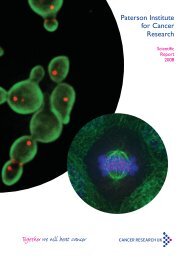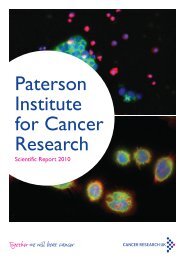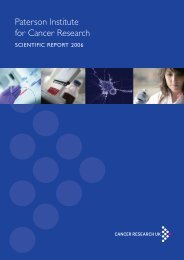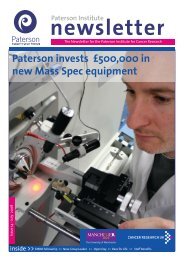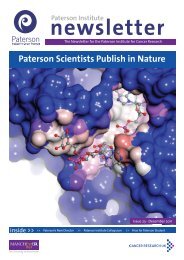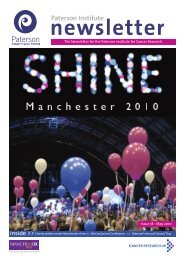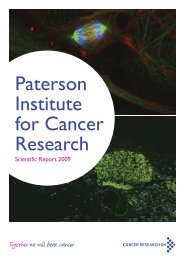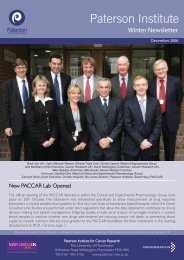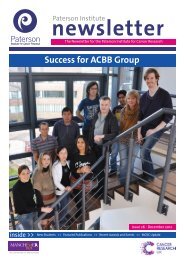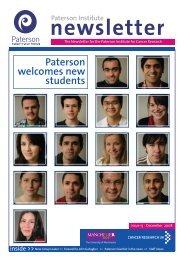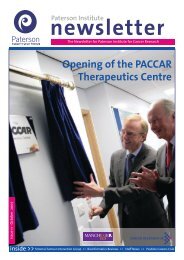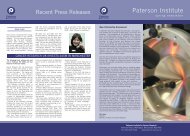Paterson Institute for Cancer Research SCIENTIFIC REPORT 2005
Paterson Institute for Cancer Research SCIENTIFIC REPORT 2005
Paterson Institute for Cancer Research SCIENTIFIC REPORT 2005
Create successful ePaper yourself
Turn your PDF publications into a flip-book with our unique Google optimized e-Paper software.
GENE THERAPY<br />
ued our studies utililising the drug-resistance genes<br />
encoding either the inactivator-insensitive P 140K<br />
mutant version of methylguanine-DNA-methlytransferase<br />
(MGMT), or multi-factoral chemoprotection<br />
by the co-expression of MGMT with either<br />
MDR1 or MRP1, both in vitro and in vivo. Lorna<br />
Wool<strong>for</strong>d has been investigating the potential of<br />
MGMT P 140K resistance to inactivation by PaTrin2.<br />
In this study we have tested the potential of<br />
MGMT P 140K to confer inactivation-insensitive<br />
protection to HSCs. She has shown in vitro that<br />
mutant MGMT confers significant resistance to the<br />
combination of PaTrin2 and temozolamide when<br />
compared with controls and subsequently in vivo in<br />
cells transduced with MGMT P 140K-2a-eGFP used<br />
to reconstitute haematopoiesis in an in vivo model.<br />
In this model she has shown protection of the<br />
gene–modified cells following cytotoxic challenge<br />
and an in vivo selective advantage. Secondary transplantation<br />
experiments indicated that this selection<br />
occurred at the level of the stem cell. To further<br />
these studies Barbara Verbeek has developed<br />
inducible version of MGMT that will add increased<br />
safety and efficacy to the gene therapy selection<br />
strategies that we have been developing.<br />
We have also initiated a study into the potential of<br />
enhancing DNA repair as a way of protecting the<br />
HSCs against other types of chemotherapeutics<br />
such as topoisomerase I inhibitors. Tom Southgate<br />
and Dorothy Gagen have over-expressed XRCC1<br />
within HSCs and demonstrated protection against a<br />
class of chemotherapeutic agents which induce<br />
high levels of collateral toxicity. This is now being<br />
tested in vivo in order to assess whether XRCC1 may<br />
also be used to aid selection. Along with Rebecca<br />
Schofield, Tom has also developed gene therapy<br />
strategies that confer radioprotection. Previously<br />
Tom had demonstrated that SOD2 conferred significant<br />
protection of the HSCs against ionising<br />
radiation. They are now working on enhancing this<br />
protection though the co-expression of Catalase<br />
which will aid in the removal of reactive oxygen<br />
species and their downstream consequences within<br />
the cell. Furthermore, Tom has examined the ability<br />
of XRCC1 to confer enhanced DNA repair after<br />
ionising radiation damage. He has shown that overexpression<br />
of XRCC1 mediates the greatest level of<br />
radiation protection yet conferred to HSCs and that<br />
the mechanism of action is likely to be through a<br />
non-classical action of the XCRR1 protein. This<br />
investigation is still ongoing but suggests that<br />
XRCC1 may be a useful tool in both chemo - and<br />
radioprotection of tissues.<br />
Modifying Macrophages to Infiltrate and Attack<br />
Tumours<br />
Previous work by our group has demonstrated that<br />
chimeric immune receptors targeted against tumour<br />
antigens can specifically direct the Antibody-<br />
Dependent Cellular Cytotoxicity (ADCC) pathway<br />
of macrophages against tumour cells expressing<br />
these antigens. Michael Lie-A-Ling has continued<br />
this work by investigating the use of lentiviral vectors<br />
in delivering chimeric immune receptors to<br />
bone marrow cells. The goal of this is not only to<br />
incorporate the chimeric receptors in a wider range<br />
of effector cells but also to incorporate these receptors<br />
in stem and progenitor cells ensuring long term<br />
production of gene modified effector cells in vivo.<br />
We are aiming to use the lentiviral technology to<br />
express chimeric immune receptors in the myeloid<br />
compartment of the immune system.<br />
P A T E R S O N I N S T I T U T E S C I E N T I F I C R E P O R T 2 0 0 5<br />
(A) Illustrates comparisons<br />
made between<br />
HOXB4ERT arrays at two<br />
timepoints. Equivalent<br />
comparisons were also<br />
made <strong>for</strong> ERT-control<br />
arrays and fold changes<br />
calculated <strong>for</strong> each probeset.<br />
(B) Illustrates scatterplots<br />
<strong>for</strong> each of these<br />
c o m p a r i s o n s<br />
(HOXB4ERT time 0 v 48h<br />
time point shown).<br />
Colours identify probesets<br />
with fold changes of ≥<br />
|1.5|; red in all 9 comparisons;<br />
blue in 8; green in 7;<br />
and purple in 6.<br />
Publications listed<br />
on page 59<br />
25


